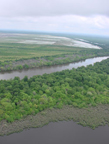Plant One for Ouachita Campaign Aims for One Million Trees in Louisiana
The Conservation Fund Nears Two Million Tree Mark for its Go Zero® program
December 4, 2012
Contacts:
- Ann Simonelli, The Conservation Fund, 703-908-5809, asimonelli@conservationfund.org
- Stacy Shelton, U.S. Fish & Wildlife Service, 404-679-7290, stacy_shelton@fws.gov

Aerial photo of Upper Ouachita National Wildlife Refuge. Photo: USFWS.

Photo: Sean Gardner for Go Zero. Download.
Photo: Go Zero. Download.
MONROE, La. (Dec. 4, 2012) – The Conservation Fund announced today it was on the verge of achieving of two spectacular milestones—the planting of its two millionth tree as part of its voluntary carbon offset program, Go Zero®, and a total of one million trees in the ground at Upper Ouachita National Wildlife Refuge (NWR) in Louisiana—all made possible via private donations.
Since 2010, donations from hundreds of thousands of individuals, together with gifts from leading companies, have been put to work at Upper Ouachita NWR to restore nearly 3,000 acres with native seedlings. As part of its “Plant One for Ouachita” campaign, The Conservation Fund will oversee two plantings at the refuge this December, which will mark the two millionth tree for Go Zero and the Fund’s one millionth tree at the Upper Ouachita NWR.
Forestland once blanketed the 46,500-acre refuge, providing shelter for ducks and bears and slowing floodwaters for communities downstream. In the 1960s, when food prices began to rise, lush forests and waterways throughout Louisiana—including the Upper Ouachita area—were slashed and burned, leaving behind a drastically altered landscape.
Today Upper Ouachita NWR is one of the largest floodplain restoration projects in the nation. The Conservation Fund, together with the U.S. Fish and Wildlife Service (USFWS) and others, aims to repair the Ouachita River’s natural hydrology and restore much of the native forestland that once covered the region. As they grow, the new forests will provide cleaner air, cleaner water for those downstream – including the cities of Monroe and West Monroe – and more places to roam for threatened species like the Louisiana black bear.
“Our partnership with The Conservation Fund’s Go Zero program has been ground-breaking,” USFWS Southeast Regional Director Cindy Dohner said. “USFWS could not have achieved what this public-private partnership has been able to accomplish. Together, we are returning significant portions of the Lower Mississippi Valley to its native state, conserving fish and wildlife, and fighting climate change. We are extremely grateful to The Conservation Fund and its donors for their work to achieve these milestones. Now let’s push ahead to another million-tree mark.”
“Over the next century, these trees will provide food and habitat for hundreds of thousands of waterfowl and other migratory birds and wildlife,” said refuge manager Joe McGowan. “It’s a partnership that has greatly improved our wetlands restoration efforts here. With the help of The Conservation Fund and its donors, Upper Ouachita NWR will continue to provide some of the very best wetlands for wildlife and the American people.”
“We are incredibly proud of our donors and honored to work with the Service to restore special places in America like Upper Ouachita NWR. Its biologists and foresters are the very best stewards we could ask for to care for these new trees,” said The Conservation Fund’s Go Zero director, Jena Thompson Meredith.
To date, The Conservation Fund’s reforestation-based carbon programs, including but not limited to Go Zero, have helped to protect and restore more than 26,000 acres with eight million trees that will trap an estimated nine million tons of carbon dioxide as the forests mature.
Learn more about Go Zero’s work at the Upper Ouachita National Wildlife Refuge.
Tree planting activities are slated for the weeks of December 10 and 17. Contact Ann Simonelli, asimonelli@conservationfund.org or Stacy Shelton, stacy_shelton@fws.gov for details.
Donors to the Fund’s forest restoration efforts benefitting Upper Ouachita NWR include: Associated Students of San Diego State University, BCBGeneration, BreatheRight, C&S Wholesale Grocers, Cbox, Dell Computer Corporation, Emkay Incorporated, Gaiam Inc., Indianapolis Colts, Iowa Natural Heritage Foundation, L’Oreal USA Inc., Land Rover Portland, Lee County Board of County Commissioners, MaCher, Momentum Group, New Jersey Natural Gas, Philadelphia Eagles, Premiere TV Inc., Sabre Holdings, SEAT Planners, ShadeFund, TerraCarbon, The North Face, Travelocity, U-Haul International, Inc., and U.S. Fish and Wildlife Service.
About the U.S. Fish and Wildlife Service
The mission of the U.S. Fish and Wildlife Service is working with others to conserve, protect and enhance fish, wildlife, plants and their habitats for the continuing benefit of the American people. We are both a leader and trusted partner in fish and wildlife conservation, known for our scientific excellence, stewardship of lands and natural resources, dedicated professionals and commitment to public service. For more information on our work and the people who make it happen, visit www.fws.gov.
About The Conservation Fund
At The Conservation Fund, we combine a passion for conservation with an entrepreneurial spirit to protect your favorite places before they become just a memory. A hallmark of our work is our deep, unwavering understanding that for conservation solutions to last, they need to make economic sense. Top-ranked, we have protected more than 7 million acres across America. www.conservationfund.com
The mission of the U.S. Fish and Wildlife Service is working with others to conserve, protect, and enhance fish, wildlife, plants, and their habitats for the continuing benefit of the American people. We are both a leader and trusted partner in fish and wildlife conservation, known for our scientific excellence, stewardship of lands and natural resources, dedicated professionals, and commitment to public service. For more information on our work and the people who make it happen, visit www.fws.gov. Connect with our Facebook page at www.facebook.com/usfwssoutheast, follow our tweets at www.twitter.com/usfwssoutheast, watch our YouTube Channel at http://www.youtube.com/usfws and download photos from our Flickr page at http://www.flickr.com/photos/usfwssoutheast.


